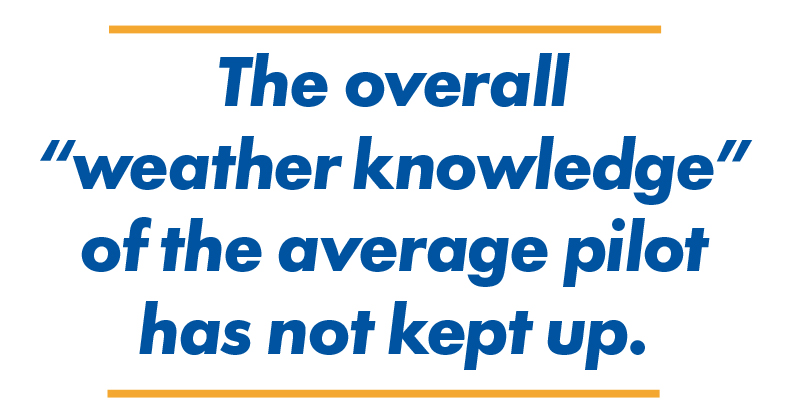By Steven Daun, National Chief Pilot
My aviation career started in the ’80s. This was before the smartphone and iPad era. We were fortunate enough to have a flight service station at our airport. Most of the time, rather than calling the FSS, we visited the office. The briefer would print out the weather charts and reports for us, give us our briefing, and we would leave with a stack of paper.
If you didn’t understand the weather, the briefer would take their time and explain everything to you. Back then, once you left the briefer, you were pretty much on your own because that was the extent of the technology and services available. Looking back on those times, I sometimes think about how fortunate we were. We learned about weather from the professionals.
Single-pilot IFR was always a challenge because you didn’t always have two nav/coms, and 99% of the airplanes didn’t have autopilots. When you flew into the clouds, the only pictures you had were created in your mind based on the briefing. This forced you to understand what was happening and forced you to develop contingency plans.
In the time since I started flying, there have been many advances in avionics and technology, especially in the area of weather reporting and depiction. Unfortunately, the overall “weather knowledge” of the average pilot has not kept up. Many don’t understand what they are reading while others have a hard time with forecasting. When you ask an IFR-rated pilot what gives them the most anxiety when flying IFR, the majority still say “weather” and most of those will narrow it down further to IFR at night.
So, where do you begin? The best place to begin is with the Surface Prog Chart. This will give you an overall view of the national weather. Once you understand where the pressure systems and fronts are, you can begin to assemble a mental picture of the weather for your route. Pick your route based on what works best for you regarding weather, schedule, and options. Don’t settle for a route just because a software package came up with one for you.
Even though you will most likely be in the clouds doesn’t mean that you don’t need to know what is below you. Take a look at a sectional and try to identify roads, fields, parking lots, race tracks, and other features that can be used in case of an emergency.
When you look at the various Sigmets, Airmets, and Center Weather advisories, they will begin to make sense based on the weather and your selected route.
METARs will give you an idea of the sky conditions and winds. This will assist you in planning your route and give you a good idea of where the nearest VFR is located. This, if close by, will become one of your contingency plans or escape routes in case of equipment issues.
Now we can begin to look at the current local weather and the forecast weather along our route. The prog chart and winds aloft chart will give us a good idea of the weather movement, while the TAF’s will confirm your thoughts.
Once you take off, it is strongly recommended to contact FSS along your route. This will enable you to adjust your weather forecasting and update your plans. Remember, all of the weather automation that you may have in your airplane depicts dated information. The information you view could be between 30 and 45 minutes old by the time it is processed and viewed in your cockpit.
Another consideration should be weather trends. Is the current weather consistent with the forecasted weather so far for the day? If not, why not and what will those differences yield? Your decisions will be much different when looking at a 300’ ceiling trending downwards than a 300’ ceiling trending upwards. The same consideration can be used en route and when selecting a possible alternate.
You should be able to take off and fly an IFR flight with the same weather confidence as you do for a VFR flight. If you can’t, find an instructor who is strong on weather and do some practical work with them both on the ground and in the air. Most anxiety for an instrument-rated pilot comes because they don’t know what is waiting for them either in the clouds or on the other side. As with other aviation skills, the weather is not a “one and done” topic to be learned during your private pilot course. The sign of a good pilot is one who is constantly learning and growing. The payback for your understanding of weather is much greater than most other investments that you could make.










